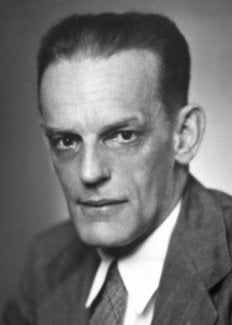Max Theiler
Biographical

Max Theiler was born on January 30, 1899, in Pretoria, South Africa, one of the four children of Sir Arnold and Emma (née Jegge) Theiler. His father was a well-known veterinary scientist. He attended local schools except for one year in Basle, Switzerland (his father was of Swiss origin), then went on to Rhodes University College, Grahamstown and the University of Capetown Medical School (1916-1918). He then went to England to study at St. Thomas’ Hospital and at the London School of Tropical Medicine, receiving his medical degree in 1922. In the same year he became a Licentiate of the Royal College of Physicians and a Member of the Royal College of Surgeons.
In 1922 he joined the Department of Tropical Medicine at the Harvard Medical School, Boston, Massachusetts, first as an assistant, then being appointed instructor. In 1930 he joined the staff of the International Health Division of the Rockefeller Foundation, becoming, in 1951, Director of Laboratories of the Rockefeller Foundation’s Division of Medicine and Public Health, New York.
His early work, at Harvard, dealt with amoebic dysentery and rat bite fever. He also worked on the problem of yellow fever, a subject in which he had become interested whilst still in London. This was to become his major interest. By 1927 he and his colleagues had proved that the cause of yellow fever was not a bacterium but a filterable virus. He also demonstrated that the disease could be readily transmitted to mice. Previously, laboratory work on this topic had been done using monkeys as experimental animals; the use of mice enabled the cost of such research to be greatly reduced. In 1930, when he joined the Rockefeller Foundation, that body was engaged in a broad attack on the problem of yellow fever. Here, Theiler and his colleagues worked on vaccines against the disease and eventually developed a safe, standardized vaccine, 17D, one advantage of which was its ready adaptability to mass production.
His other work for the Institute has been connected with the causes and immunology of certain disorders which include Weil’s disease. He has also been engaged in research on dengue fever and Japanese encephalitis. The problem of poliomyelitis has been of great interest to him and he discovered an apparently identical disorder in laboratory mice which is now sometimes called Theiler’s disease (encephalomyelitis).
Dr. Theiler has been a contributor to two books, Viral and Rickettsial Infections of Man (1948) and Yellow Fever (1951). He has also written numerous papers in The American Journal of Tropical Medicine and Annals of Tropical Medicine and Parasitology.
Honours awarded to him include the Chalmer’s Medal of the Royal Society of Tropical Medicine and Hygiene (London, 1939), the Flattery Medal (Harvard, 1945), and the Lasker Award of the Lasker Foundation (1949).
He married Lillian Graham in 1928. They have one daughter.
This autobiography/biography was written at the time of the award and first published in the book series Les Prix Nobel. It was later edited and republished in Nobel Lectures. To cite this document, always state the source as shown above.
Max Theiler died on August 11, 1972.
Nobel Prizes and laureates
Six prizes were awarded for achievements that have conferred the greatest benefit to humankind. The 14 laureates' work and discoveries range from quantum tunnelling to promoting democratic rights.
See them all presented here.
